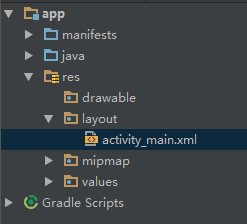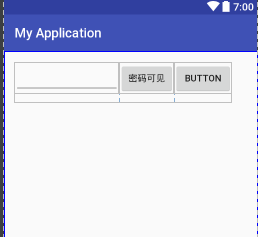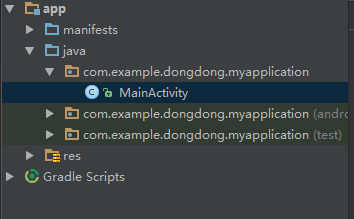参考教程:
3.1.1 基于监听的事件处理机制
http://www.runoob.com/w3cnote/android-tutorial-listen-event-handle.html
3.5 监听EditText的内容变化
http://www.runoob.com/w3cnote/android-tutorial-listener-edittext-change.html

http://blog.csdn.net/u010924834/article/details/48753835
过程记录

1布局管理器
1.1添加一个布局管理器
1.2添加两个按键


<?xml version="1.0" encoding="utf-8"?>
<android.support.constraint.ConstraintLayout xmlns:android="http://schemas.android.com/apk/res/android"
xmlns:app="http://schemas.android.com/apk/res-auto"
xmlns:tools="http://schemas.android.com/tools"
android:layout_width="match_parent"
android:layout_height="match_parent"
tools:context="com.example.dongdong.myapplication.MainActivity">
//1.1 布局管理器
<LinearLayout
android:layout_width="330dp"
android:layout_height="61dp"
android:layout_margin="5dp"
android:orientation="horizontal"
tools:context=".MainActivity"
tools:layout_editor_absoluteX="16dp"
tools:layout_editor_absoluteY="16dp">
//1.2 添加文本框
<EditText
android:id="@+id/edit_pawd"
android:layout_width="0dp"
android:layout_height="48dp"
android:layout_weight="2"
android:inputType="textPassword" />
//1.3 添加按钮 按钮改变 密码显示和隐藏
<Button
android:id="@+id/btnChange"
android:layout_width="3dp"
android:layout_height="48dp"
android:layout_weight="1"
android:text="密码可见" />
// 1.4 添加按钮 按钮单击 输出一句话
<Button
android:id="@+id/btnshow"
android:layout_width="wrap_content"
android:layout_height="wrap_content"
android:text="Button"
tools:layout_editor_absoluteX="16dp"
tools:layout_editor_absoluteY="94dp" />
</LinearLayout>
</android.support.constraint.ConstraintLayout>
2 主函数

2.0 导入包
2.1 声明变量
- private EditText edit_pawd; // 文本框
- private Button btnChange; // 按键1
- private boolean flag = false; //判断
- private Button btnshow; //按键2
2.2 绑定变量与实际按键
- edit_pawd = (EditText) findViewById(R.id.edit_pawd);
- btnChange = (Button) findViewById(R.id.btnChange);
- btnshow = (Button) findViewById(R.id.btnshow);
2.3 绑定按键的方法
第一种模式 1)直接用匿名内部类
- 平时最常用的一种:直接setXxxListener后,重写里面的方法即可; 通常是临时使用一次,复用性不高!
btnChange.setOnClickListener(new View.OnClickListener() { public void onClick(View view) { //按键事件触发 } });
第二种模式 2)使用内部类
- 和上面的匿名内部类不同哦! 使用优点:可以在该类中进行复用,可直接访问外部类的所有界面组件!
先写方法
class BtnClickListener implements View.OnClickListener { public void onClick(View v) { // 按键单击动作 } }
然后new出来
btnshow.setOnClickListener(new BtnClickListener());
注意:方法要在调用前出现
package com.example.dongdong.myapplication;
import android.support.v7.app.AppCompatActivity;
import android.os.Bundle;
import android.text.method.HideReturnsTransformationMethod;
import android.text.method.PasswordTransformationMethod;
import android.view.View;
import android.view.View.OnClickListener;
import android.widget.Button;
import android.widget.EditText;
import android.widget.Toast;
import android.app.Activity;
public class MainActivity extends AppCompatActivity {
private EditText edit_pawd; // 文本框
private Button btnChange; // 按键
private boolean flag = false; //判断
private Button btnshow;
@Override
protected void onCreate(Bundle savedInstanceState) {
super.onCreate(savedInstanceState);
setContentView(R.layout.activity_main);
edit_pawd = (EditText) findViewById(R.id.edit_pawd);
edit_pawd.setHorizontallyScrolling(true); //设置EditText不换行
btnChange = (Button) findViewById(R.id.btnChange);
btnChange.setOnClickListener(new View.OnClickListener() {
@Override
public void onClick(View view) {
if(flag == true){
//设置文本框隐藏模式
edit_pawd.setTransformationMethod(HideReturnsTransformationMethod.getInstance());
flag = false;
btnChange.setText("密码隐藏");
}else{
//设置文本框可见模式
edit_pawd.setTransformationMethod(PasswordTransformationMethod.getInstance());
flag = true;
btnChange.setText("密码可见");
}
}
});
//定义一个内部类,实现View.OnClickListener接口,并重写onClick()方法
class BtnClickListener implements View.OnClickListener
{
@Override
public void onClick(View v) {
Toast.makeText(getApplicationContext(), "按钮被点击了", Toast.LENGTH_SHORT).show();
}
}
btnshow = (Button) findViewById(R.id.btnshow);
//直接new一个内部类对象作为参数
btnshow.setOnClickListener(new BtnClickListener());
}
}